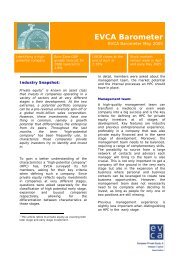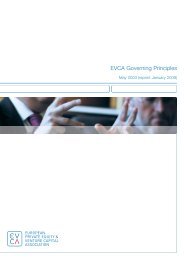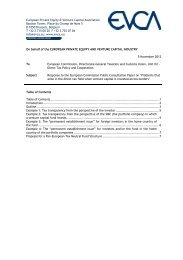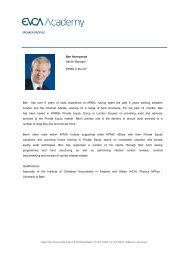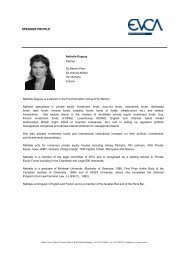Risk Measurement Guidelines - EVCA
Risk Measurement Guidelines - EVCA
Risk Measurement Guidelines - EVCA
You also want an ePaper? Increase the reach of your titles
YUMPU automatically turns print PDFs into web optimized ePapers that Google loves.
Co-investments: overview of main risks to be consideredCo-investments are generally subject to all the main risksthat apply to investments in private equity funds 15 , but theyare also characterised by idiosyncratic risk factors.All the following risks should be considered for effective riskmeasurement of co-investments:I. Funding riskGenerally, there is no contractual or legal obligation to fundadditional financing rounds in the case of co-investments.Consequently, funding risk is minimal or non-existent.Nevertheless, there is a degree of funding risk associatedwith equity injections, e.g. in the context of expansionprogrammes (e.g. buy and build strategies), to complywith debt covenants and, in worst case scenarios, toremain solvent (see paragraph IV below on capital risk).II. Liquidity risk:The secondary market for co-investments is arguably moreilliquid than the funds secondary market. This exposesinvestors to a high degree of liquidity risk. This needs tobe taken into account and measured.III. Market risk:Co-investments are typically valued at fair market valuein line with the International Private Equity and VentureCapital Valuation <strong>Guidelines</strong> and could therefore beheavily influenced by market movements. Market risk isrelevant both for unrealised value (i.e. when investmentsare held in the investor’s balance sheet) and realisedvalue (i.e. cash inflow in case of exit) of co-investments.15 Please refer to section 4 for more details.IV. Capital riskCapital risk is defined as the risk of losing investedcapital as a result of idiosyncratic factors impacting singleco-investments. These idiosyncratic factors can be dividedin two main categories:a. Capital structure, cash flow and default risk:Balance sheet and cash flow risks are key risks forco-investments. In leveraged capital structures,weak cash flow and poor performance could lead todebt covenant breaches and, in a worst case scenario,to default and write-off of the investments.b. Operational risks: Operational risks in the context ofco-investments’ risk measurement are defined asidiosyncratic factors that could impact portfoliocompanies’ earnings and profitability. Operational risksof co-investments vary across sectors, geographies andportfolio companies’ sizes but they typically include:- Quality of a portfolio company’s management- Credibility and quality of management and boardinformation and accounts- Credibility and achievability of budget and businessplan, including revenue growth, margin improvementsand future cash flow generation- Investors’ level of influence in board and managementdecisions- Supply risk, including reliance on specific suppliers,commodities and markets- Demand risk, including reliance on specific clients,distribution channels and markets- Compliance and regulatory risks- Legal and contractual risks- Environmental, social and governance risks- Quality of relationship and alignment with generalpartnersV. Foreign exchange riskFX risk should be also considered and should be analysedfrom two points of view:a. Currency of investmentb. FX exposures in the portfolio company’s balance sheet,income and cash flow statementsBase models to measure co-investment riskSimilarly to funds, private equity co-investments risks can bemodelled using a variety of approaches and methodologies.The model selection factors and the two main types ofmodelling methodologies described in Section 4 of this paper- the NAV-time series and cash flow projection-basedmodelling approaches - are also applicable to co-investments.Additionally, the following two high-level risk modellingapproaches can be adopted for co-investments:I. Bottom-up approachThis approach can be adopted for measuring the risk ofsingle co-investments and portfolios of co-investments.The bottom-up approach entails detailed analysis,assessment and quantification of single co-investmentfunding, liquidity, market and capital risks. When measuringthe risk of portfolios of co-investments, correlationsacross single portfolio companies will also need to beconsidered.<strong>EVCA</strong> <strong>Risk</strong> <strong>Measurement</strong> <strong>Guidelines</strong> 2013 I 29



